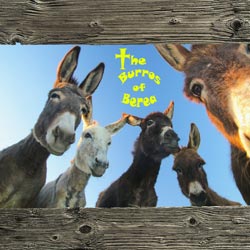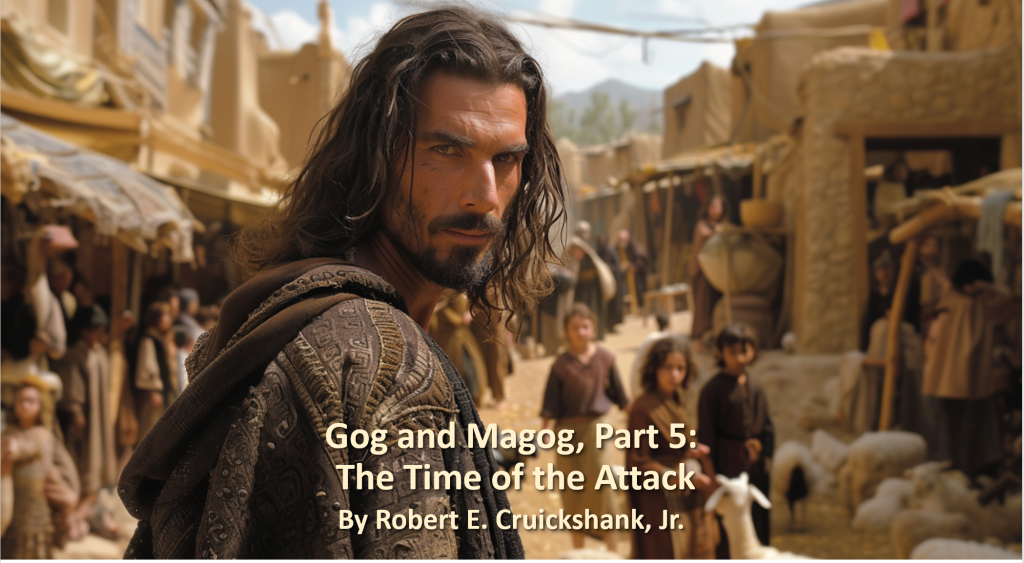Gog and Magog, Part 5: The Time of the Attack
Copyright © Robert E. Cruickshank, Jr. (March 1, 2024)
All Rights Reserved
“After many days you will be mustered. In the latter years you will go against the land that is restored from war, the land whose people were gathered from many peoples upon the mountains of Israel, which had been a continual waste. Its people were brought out from the peoples and now dwell securely, all of them. You will advance, coming on like a storm. You will be like a cloud covering the land, you and all your hordes, and many peoples with you” (Ezekiel 38:8-9).
Picking up where we left off[1] and moving along in the passage, verse 8 is a time text of sorts – telling us when this attack of Gog would come: “After many days, you will be summoned: in the latter years, you will come into the land that is restored from the sword…” (Ezekiel 38:8). And verse 16 uses the phrase “the last days” (NASB) or “latter days” (ESV), or “end of days” (JPS), depending on which translation you use. Many assume these are technical terms for the end of the world,[2] but such isn’t the case.
Latter Days in the Old Testament
The first usage of such a term in the Bible is Genesis 49:1: “Then Jacob called his sons and said, ‘Gather yourselves together, that I may tell you what shall happen to you in days to come.’” The phrase “in the days to come” is literally in “the end of days.” But this isn’t talking about the end of the world or even an Arnold Schwarzenegger movie from the late 90s.[3] Jacob’s words here are fulfilled in the lifetime and future of his own descendants.[4]
Deuteronomy 31:29 is similar. Moses tells the people of Israel:
“For I know that after my death you will behave very corruptly and turn from the way which I have commanded you; and evil will confront you in the latter days, because you will do that which is evil in the sight of the Lord, provoking Him to anger with the work of your hands” (Deut. 31:29).
In this context, “the latter days” simply means the days following Moses’s death. After Moses was gone, they would behave corruptly and do evil in the sight of the Lord. It didn’t take long for this to happen. In fact, it happened rather quickly. In Judges 2:20-21, we read:
“So the anger of the Lord burned against Israel, and He said, “Because this nation has violated My covenant which I commanded their fathers, and has not listened to My voice, I in turn will no longer drive out from them any of the nations which Joshua left when he died” (Judg. 2:20-21).
As Gary DeMar writes, “In many cases, the Hebrew word often translated ‘last days’ means nothing more than ‘in future days,’ ‘a later time,’ or ‘in days to come.’ Old Testament Hebrew does not have a word for ‘future’ or ‘in the distant future’… Moses isn’t skipping over thousands of years of history to describe what will happen in the distant future. The ‘the latter days’ in Deuteronomy actually refers to the period of the Judges.”[5]
Moab in the Latter Days
Jeremiah 48:47 says, “I will restore the fortunes of Moab in the latter days.” There is some question as to whether or not “fortunes” is the best translation of the Hebrew word shevit in this instance. Your Bible may even contain a marginal note indicating that “captivity” is possibly a better rendering.[6] Either way, whether Jeremiah is speaking of the restoration or captivity of Moab, the point here is that this nation no longer exists. The Moabites “disappeared from history” after being “conquered by the Babylonians in 582 BC.”[7]
While the pop-prophecy pundits of our day continue to claim that expressions such as “the latter days” and “the last days” refer to “the end of the world” and “describe still future events,”[8] more scholarly resources indicate otherwise. Scholars recognize that the Biblical usage of such expressions means that these are not technical terms for the end of world history.
Ezekiel’s Latter Days = Esther’s Current Days
According to The Theological dictionary of the Old Testament, in and of themselves, these expressions simply mean “in the after(wards) of days,” “in the following days,” “in the course of time,” “in the future.”[9]
Hence, the Brown-Driver–Briggs (BDB) Hebrew and English Lexicon of the Old Testament translates Ezekiel 38:16 as “in the end of days” and defines it as “a prophetic phrase denoting the final period of the history so far as the speaker’s perspective reaches; thus the sense varies with the context…”[10]
Ezekiel is writing sometime after the Babylonian exile, and the events of the book of Esther take place shortly after the return from exile. This fits the historical context “of the speaker’s perspective.”
While he doesn’t make the connections to the book of Esther per se, even Daniel Block recognizes that “both expressions refer simply to a later time, when the historical phase of the exile is over and the new period of settlement in the land has arrived.”[11]
Dwelling Securely After the Exile
The text gives us some very specific details regarding this “historical context from the speaker’s perspective” and this “historical phase when the new period of settlement in the land has arrived.” Gog’s attack would come at a time when God’s People are “now dwelling (yashav) securely, all of them” (Ezek. 38:8b). In verse 14, it says of Gog: “On that day, when my people are dwelling securely, will you not know it?” It is a time when the land had been “restored from war” and God’s people were “gathered” back to their homeland which had formerly been a “continual waste” (Ezek. 38:8).
This aptly describes the situation during the time of Ezra, Nehemiah and Esther when God’s People had returned from exile and the restoration had begun. Ezra tells us that all Israel was once again living in their own cities (Ezra 2:70) and the people were gathered together “as one man” (Ezra 3:1). Nehemiah reiterates this, all the sons of Israel were back home in their own cities (Neh. 7:73), and everyone “lived (yashav) on his own property” (Neh. 11:3). This is the same word that Ezekiel uses in Ezekiel 38:8.
The Persians, who had liberated Judah from Babylon, were fully assisting the Jews in the restoration effort (Ezra 1). The Assyrians, who had taken the ten northern tribes captive in 722 BC, were now aiding the Jews in the rebuilding of the temple. Ezra 6:22 says that “the Lord” had “turned the heart of the king of Assyria toward them to encourage them in the work of the house of the God, the God of Israel.”
To sum it up, their most recent enemy, Babylon, was no longer a threat. Their more ancient enemy, Assyria, was now their ally. And they had the full support of Persia, the empire that was now in power. Things couldn’t have been better for God’s people at this time. Everyone who wanted to return was back home, and the other nations were no longer a danger to them. All those who chose to return went back to their own land. The Jews’ situation, at the time of Ezra, Nehemiah and Esther, perfectly fits the scenario that Ezekiel describes as the time when Gog’s attack comes. It is a time when all Jews were truly dwelling “securely” in every sense of the word.
In our next installment, we’ll take a look at the pivotal moment when Gog began to scheme his attack and how this continues to tie the events of Esther to the prophecy of Ezekiel.
________________________________________________________
[1] https://burrosofberea.com/gog-and-magog-part-4-gogs-allies-and-esthers-enemies/
[2] https://lifehopeandtruth.com/prophecy/end-times/last-days/
[3] https://en.wikipedia.org/wiki/End_of_Days_(film)
[4] Some take the term to “Shiloh,” in verse 10, as a reference to Christ. But this is doubtful. The word “Shiloh” appears 33 times in the Old Testament, and it always refers to the city of Shiloh in Ephraim, about 24 miles north of Jerusalem.
If the “Shiloh” of verse 10 is speaking of Jesus, the scepter did not depart from Judah with him because He was the Lion of the Tribe of Judah (Rev. 5:5). The Herods were in control of Judea long before Jesus came along, and the Herods were Edomites. So, the scepter had already departed from Judah long before Jesus ever came on the scene. If anything, the Lion of the Tribe of Judah (Jesus) was taking the scepter back.
Historically, the scepter departed from Judah with Solomon’s son as a result of Solomon’s sin (1 Kg. 11:11-13). And it happens when Ahijah the prophet reveals to Jeroboam that God will “tear the kingdom out of Solomon’s hands” and give him ten of the tribes (1 Kg. 11:31-32). And Ahijah the prophet was a “Shilonite” (1 Kg. 11:29; 12:15; 15:29). In other words, he was “an inhabitant of Shiloh” (according to STEP Bible, Tyndale House). So, Shiloh came, and the scepter departed.
For a good, peer-reviewed resource on the meaning “Shiloh” in Genesis 49:10, see: Marco Treves, “Shiloh (Genesis 49:10),” Journal of Biblical Literature, Vol. 85, No. 3 (September 1966).
[5] Gary DeMar, The Gog and Magog End-Time Alliance: Israel, Russia, and Syria in Bible Prophecy (Powder Springs, GA: American Vision Press, 2016), pp. 94-95.
[6] For example, the NASB 1995.
[7] https://www.britannica.com/place/Elam
[8] https://www.churchofgodacf.ca/q-a-3258/
[9] G. Johannes Botterweck and Helmer Ringgren eds., Theological Dictionary of the Old Testament, Volume 1 (Grand Rapids, MI: William B. Eerdmans Publishing Company, 1997), pp. 210-211.
[10] Francis Brown, S. R. Driver, and Charles Briggs, eds., A Hebrew and English Lexicon of the Old Testament (Oxford University Press, [1907] 1976), 31. Emphasis added.
[11] Daniel I. Block, The Book of Ezekiel: Chapters 25-48 (Grand Rapids, MI: William B. Eerdmans Publishing Company, 1998), p. 443.

